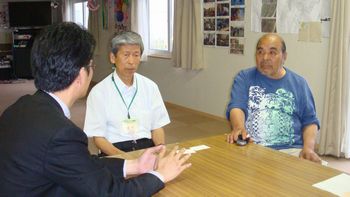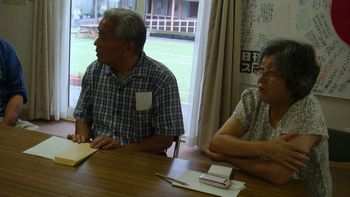What It Means to Support Standing on Your Own Feet
One of the non-governmental organizations (NGOs) that Tohoku HELP has established is the Wakabayashi Help. Along with the Food Radiation Measurement Centers and the Non-Japanese Disaster Survivors Support Center, it is one of the central projects of Tohoku HELP.
The website for Wakabayashi Help is now up and running, and can be accessed from http://wk-help.com .
In the evening of July 20th, I, Kawakami, and Reverend Abe from the Tohoku HELP office met with members of the Higashi-Dohri Temporary Housing Neighborhood Association and discussed our past, present and future.
Here, I would like to report about that discussion, reintroducing the Wakabayashi Help and rethinking what it means for disaster survivors to be standing on their own feet.
Tohoku HELP was established on March 18th, 2011.
To aid disaster survivors get back on their feet and establish a community, the Grand House Project, targeting all areas of the earthquake disaster, was set up on July 1st, 2011. The project has just entered its second year.
The Grand House Project placed its headquarter (the Tohoku HELP office) in Sendai City, aiming to set up local offices on disaster sites.
The project advanced on oiled wheels, and with financial help from in and out of the country, we registered the Tohoku Diakonia Foundation as the secretariat in September 2011, and established the Wakabayashi Help on October 1st of the same year, setting up a support office in the Higashi-Dohri Temporary Housing quarter in Sendai. Our intent to hear the voices of the disaster survivors from the local site and help link the world with the entire region began to take shape from this point.
Today, it is 2012, and the Grand House Project, as known, has made great accomplishments. This is all in great gratitude to the blessings from our Lord and prayers from all. This past June, as the Grand House Project was about to end its first year, we met a turning point. We were not able to raise funds as planned, but with the support of many prayers, we were able to start the second year with renewed feelings, revisiting the original intentions of the project.
Coincidentally, the Wakabayashi Help was also passing a turning point, moving its office from the Higashi-Dohri Temporary Housing quarter to Minami-Koizumi JR (Japan Railway) Temporary Housing quarter, also in Sendai City.
Even in the same Sendai city, the temporary housing quarters are situated very differently. Some are large and are able to receive much support, such as the Higashi-Dohri Temporary Housing quarter, and some are small and do not get all the help they need. One must also not forget that there are survivors who live in rent, aided by public expense (it is said that there are four times as many who do so than those who live in temporary housing).
The Minami-Koizumi JR Temporary Housing quarter is a mid-sized quarter that is reusing a building that once was the company housing of Japan National Railways, back when it was run by the government. Thus, the building itself was quite decrepit, and, like other rent neighborhoods, lacked a community. The Wakabayashi Help intended to challenge this problem by moving to Minami-Koizumi JR Temporary Housing quarter.
Hearing this, Tohoku HELP met with the Higashi-Dohri Temporary Housing Neighborhood Association and the director of civil service, and reached a solution. From July on, our support project for the Higashi-Dohri Temporary Housing quarter is to go to the next stage.
So, what is the next stage? The next stage is in increasing the autonomy of the Neighborhood Association, and through doing so, having the disaster survivors get back on their own two feet.
When one moves into temporary housing, he/she usually gets caught up in adapting to the new environment. Tohoku HELP established Wakabayashi Help to hold headquarters within the temporary housing quarter and help those people get started up a new living. After a whole year with the project, a new order has begun to rise from the community. Thus, in the evening of the 18th, we discussed and decided that we should move to “the next stage”, where the Neighborhood Association will begin to gain autonomy, with Tohoku HELP as its counselor. Matter of a fact, not moving to the next stage will eventually cause all support project nothing more than frustration.
We, Tohoku HELP, run our support projects on three principles. They are as follows;
Prepare and wait. Whether it be a thing, service or information, never press it on to somebody.
Always be prepared, to be able to respond quickly to a call for help.
Keep a fresh eye and create. Never mechanically apply past successes.
Help with ingenuity.
Pray for the hidden. Remember everybody you meet and pray for them. But, do not make a big show of it. (Remembering Matthew 6.2)
These three principles are what we learned from being on the site. The time has now come for us to make these principles take shape. That is what it means to be self-standing. We are beginning our second year, learning much from everybody at the site.
That is all for the report, introduction, and my thoughts on disaster survivors’ standing on their own feet.
July 20th, 2012, Naoya Kawakami



